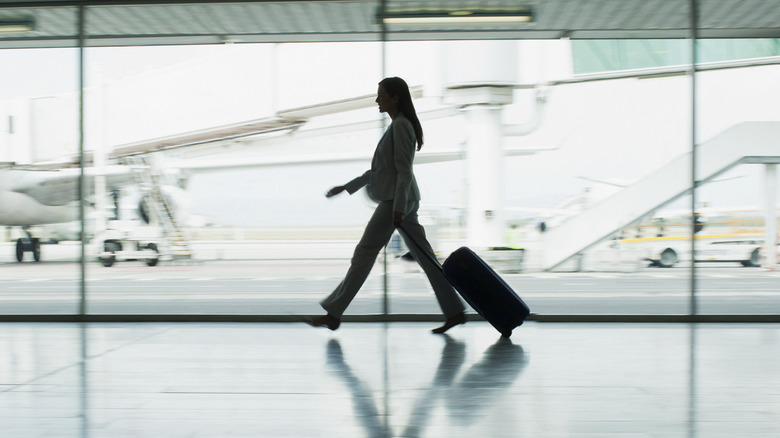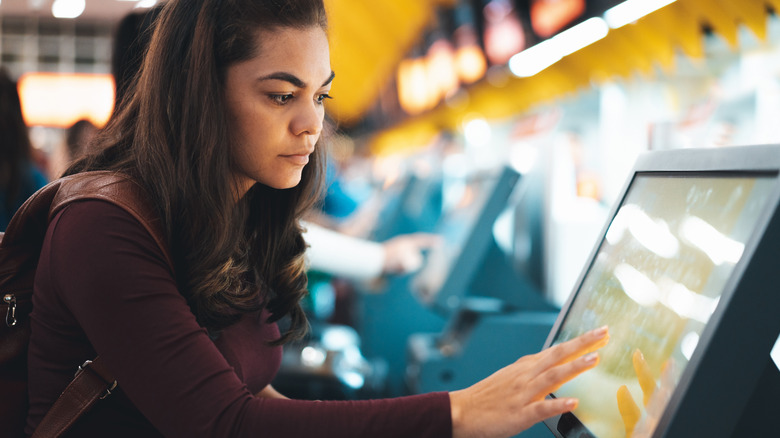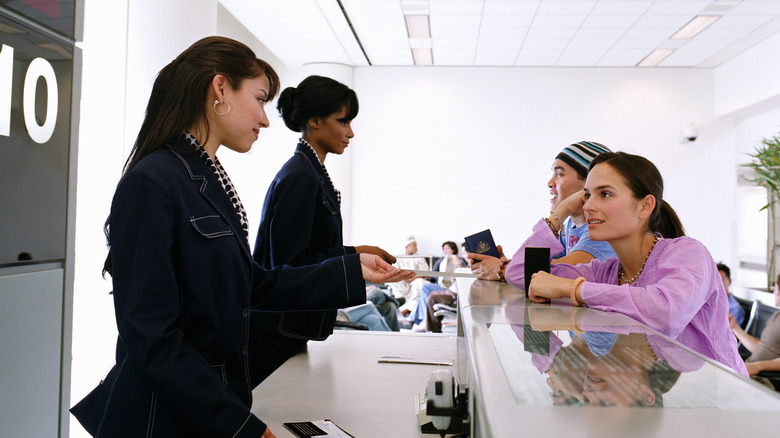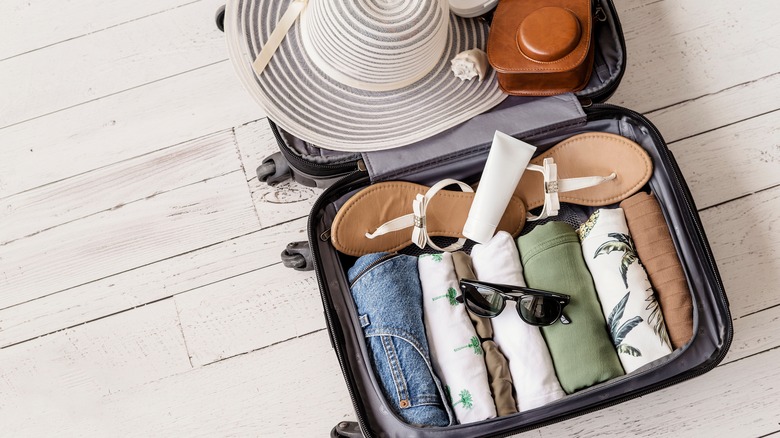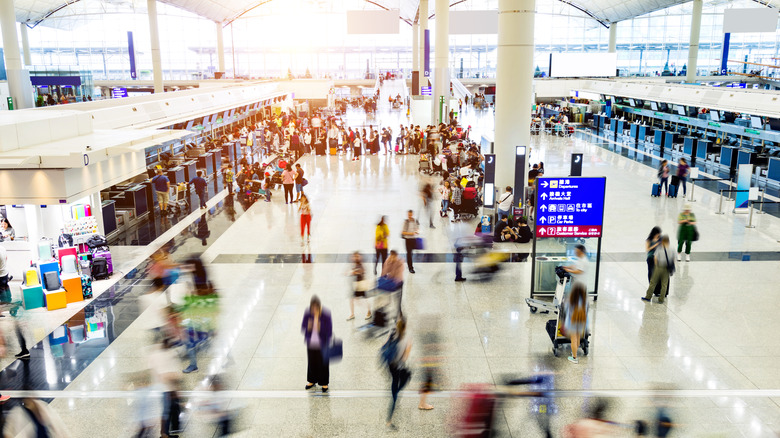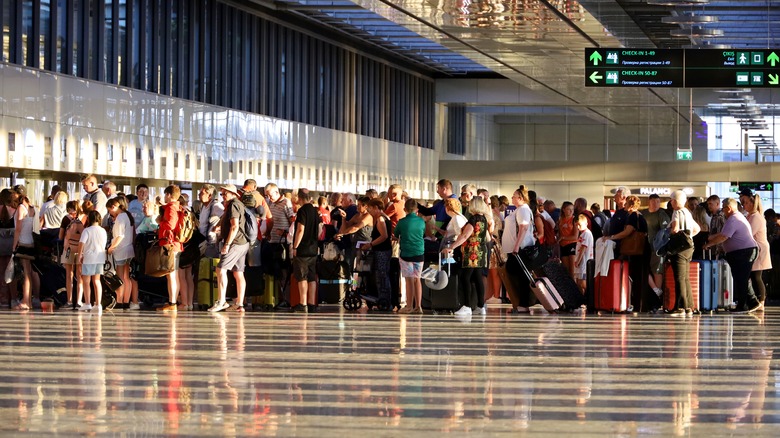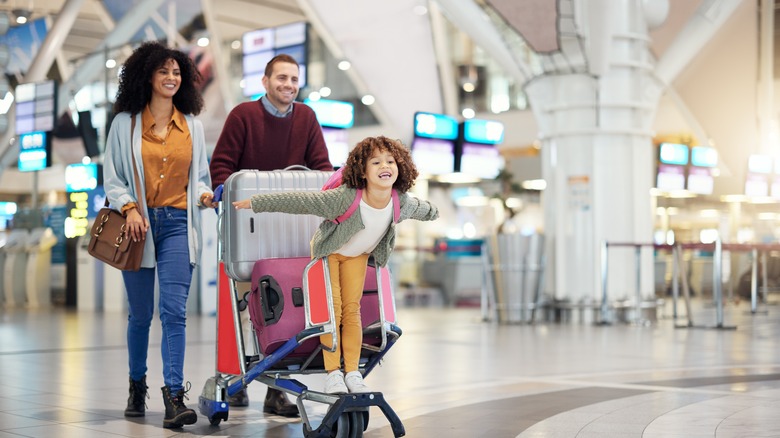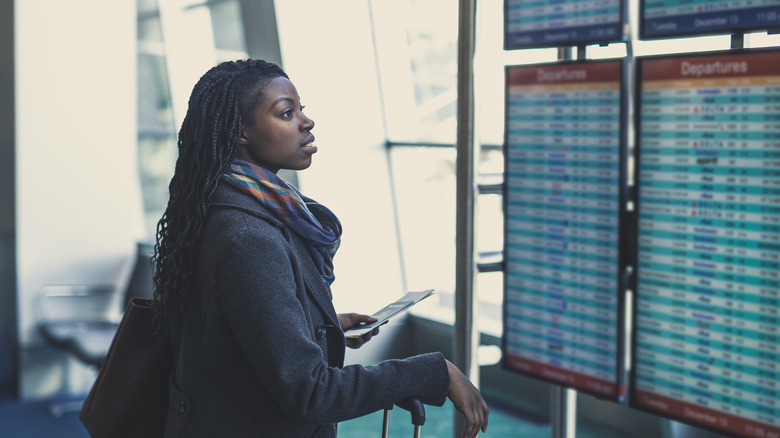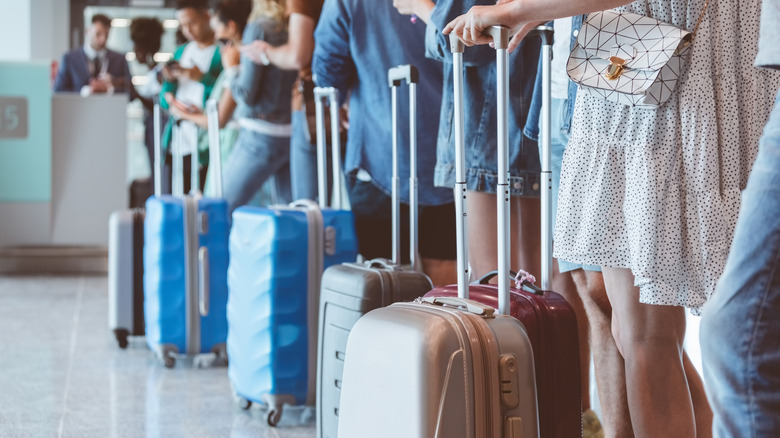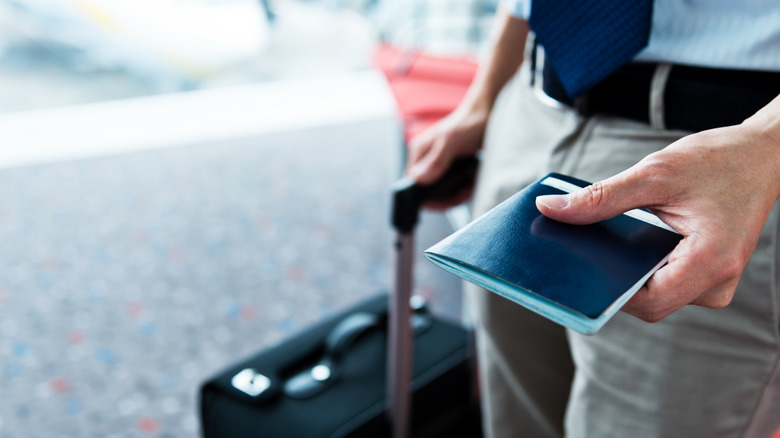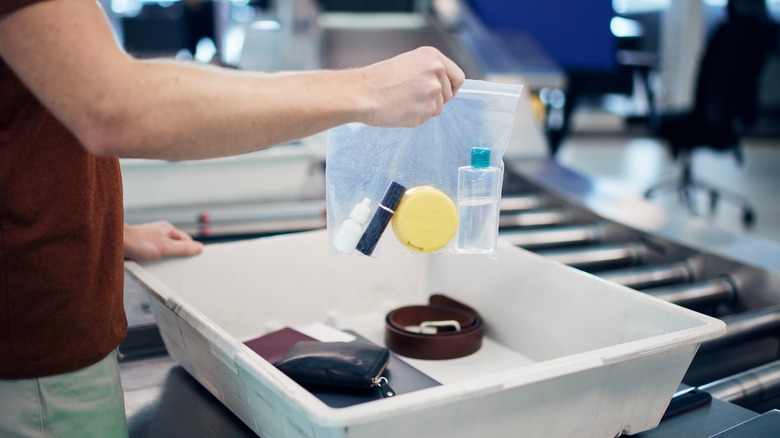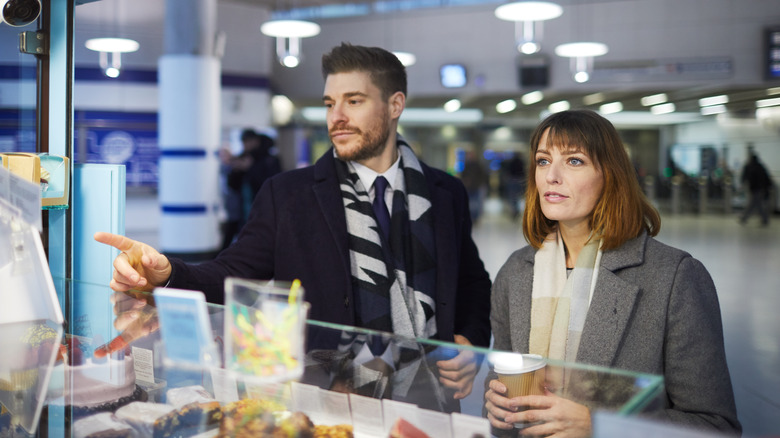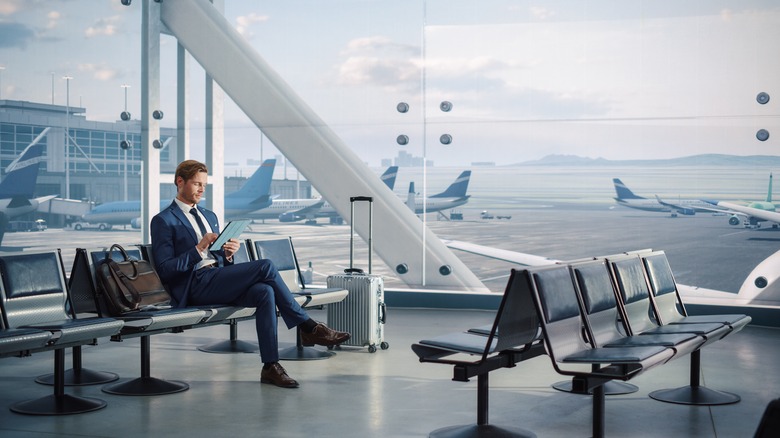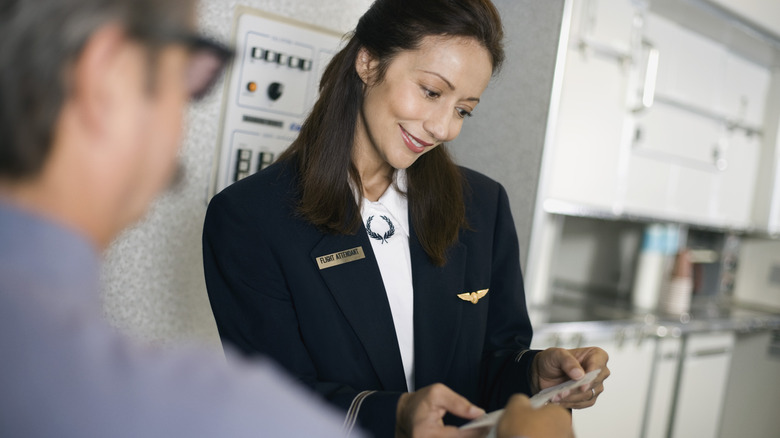What To Expect At The Airport If You've Never Flown Before
Many of us have flown multiple times, and know the drill when arriving at the airport. But, for first-time fliers, an airport can be a scary place, daunting for its regulations, procedures, stark lighting, stringent security, and officials laden with an apparent lack of mirth. From the moment a traveler steps into a terminal, the time leading up to the point of boarding the plane can be nerve-racking, making them feel constantly on edge, and not knowing what to expect. Unlike taking a train or a bus, flying is a much more controlled method of travel, with strict rules and protocols to ensure the safety of passengers and airline staff.
After the terrorist attacks of 9/11, airport security came under the microscope, and the changes implemented ever since — only passengers allowed past security checkpoints, limits on the liquids that could be put in a carry-on bag, more thorough screening on personal items — seemed draconian at the time, even if it's commonly accepted now. For frequent travelers, the airport journey is almost done on automatic, a cruise-control of sorts of handing over documentation, placing items in plastic bins and then retrieving them, scanning screens and signs to see where to go, and killing time before finally shuffling onto the aircraft. For newbies, however, a few simple pointers will help them forge a smooth ride all the way to the gate.
Check-in online
There was a time, not long ago in fact, when check-in for a flight was only available at the terminal, and was done at the moment passengers actually went to the airport to catch the flight. Here, travelers would patiently wait in snaking lines (you probably will still see these at some point during your first foray into the airport), before approaching a check-in counter to have their documents looked over and boarding passes issued. This was the format for eons, but this began to change in 1999 when online check-in was introduced to the world by Alaska Airlines.
Back then, the new option for preparing for a flight was revolutionary, but today, a little over two decades later, it is considered an essential part of the flying process (in fact, passengers often get annoyed when they are unable to check in online). Online check-in for flights usually opens 24 hours before the flight departure (for some airlines, even prior to that), and can be done on an airline's website or app under a "check-in" tab. Travelers simply need to enter their booking information (typically the six-digit-and-letter confirmation of the booking, or the e-ticket number, and their family name) before proceeding to affirm some details, plug in some information about travel documents, and choose their seat if they haven't already done so. At the end of the process, you should be able to access your boarding pass.
Be prepared
Taking a flight is an exciting adventure — and the first flight is doubly so — and the build-up and anticipation are something that you will feel in your stomach for days beforehand. Don't derail that sense of wonder by doing something as simple as not having your paperwork in order. It's important to triple-check all your documentation a few days before the flight, perhaps even put everything aside in a folder so that it's all together. For domestic flights, a state ID is fine, but for international trips, travelers will need a passport, so make sure you have a valid passport, one that has at least six months of validity past the date that you plan to return from your trip.
In addition, you should have a copy of your boarding pass, and it's worth also carrying a copy of your booking/reservation information together with any luggage purchased to show the check-in agent in case of a dispute. You might also need to show visas for entry to a country, depending on where you are traveling, and proof of vaccinations if you are visiting a country that requires them (when going to Brazil, for instance, the CDC recommends travelers have a yellow fever vaccination).
Pack smartly
Ever since the changes following the attacks on 9/11, there has been an increase in restrictions on what passengers can bring onboard the plane in their carry-on baggage. Prior to then, bringing a liter of Fruit Punch Gatorade, for instance, into the cabin wouldn't have raised any eyebrows, but that luxury is no more. Travelers will need to limit their liquid, gel, or aerosol carry-on items to less than 3.4 ounces each (or 100 ml), and all of these items must fit inside a clear, quart-sized sealable bag. Anything that won't fit in will need to be packed in check-in luggage or left behind at home — better that than have security throw it away at screening.
Note that toothpaste is considered a liquid for these purposes, so don't bring a full tube of toothpaste in your carry-on, or a giant, expensive bottle of perfume or cologne. If you are bringing a laptop, have it handy, because it usually needs to be removed for security screening. It's also a good idea to bring your own headphones if you plan to watch something on the onboard screen or on your phone. Some airlines do give out free or cheap headphones, but the quality of them, as you'd expect, is rarely commendable, and certainly not good enough to block out the sounds of the plane engine, the other passengers, and the general cabin hullabaloo.
Confirm your terminal
For smaller regional airports, and even some international airports for small destinations, like some islands in the Caribbean, the airport is usually separated simply into Departures and Arrivals. Bigger airports deviate from that model for obvious reasons and have multiple terminals, some of which can be quite some distance from each other. At London's Heathrow Airport, for instance, Terminals 4 and 5 sit miles away from Terminals 1, 2, and 3. Wherever you are flying, and from whatever airport, it's key to know which terminal your flight will depart from. This information is sometimes listed on the reservation information in your booking (you can locate the details of your booking on a tab of the airline's website that is usually listed as "Manage Booking" or something similar).
Some airlines also have their own terminals at airports, where all their flights depart from (or arrive), especially for legacy carriers like American Airlines and Delta. But, this isn't always the case, and sometimes one airline might use different terminals within an airport depending on the destination flown. If you can't find the information easily, the best option is to call the airline reservations number and speak with an agent — provide them with the date of the flight and flight number/information and they will be able to advise the relevant airport terminal. Do this well in advance of the flight. Note that at large airports, departure halls are typically located above street level, while arrivals are at ground level.
Don't be late
Suggested check-in guidelines are two hours prior to a domestic flight and three hours before an international flight. These might seem like vast tracts of time, but you have to respect the process. While we all hope for airport check-in and screening procedures to go smoothly, and lots of work has gone into honing those processes at airports around the world, these necessary parts of travel are often beset by lines, delays, and interruptions. For travel around holiday periods, lines at check-in and screening can be interminably long and frustratingly slow, but as long as you have arrived at the airport when you are supposed to, you will get on the flight.
Check-in counters for a flight close an hour before the flight departure time (sometimes less for domestic flights, but use the hour as a reliable benchmark) — so if your plane leaves at 7 p.m., for instance, and you show up at 6.01 p.m., it's possible that you won't be given a boarding pass or have your bags checked in. You will also count as a "no-show," which means that you didn't show up at all (and you might get charged to be booked on the next available flight). While smaller airports take less time to get through than larger ones, it's still wise to follow the above guidelines, whatever the airport's size. And even if your flight is delayed, and you know it is, you must show up based on the original timings of the flight.
Dress wisely
A bit like a botanic garden conservatory, or the freezer section of a supermarket, airports are their own ecosystems, immune to the vagaries and whims of the weather outside. They can be frigid cold in the height of summer, and toasty warm when there is four feet of snow outside, so it's important to wear layers that you can easily remove and replace. (As an aside, the interior of planes seem to share the same sense of independent conditions, they can be sweltering and freezing, all within the span of minutes). The key to making it through the travel travails is to dress comfortably, wearing something that is easy to move around in and doesn't pinch or bunch or snag when sitting for expected periods of time.
This is why many travelers opt for sweatpants and a sweatshirt when flying, as these are flexible, roomy, soft, and cushioning, all attributes that will help make the trip a little less taxing. While some passengers might think of an airport as a place packed with scores of people that need to be impressed, or a great realm to show off the latest fashionable look, we suggest that you resist the urge to dress as if you are attending a special event or putting on a catwalk show. It's just not worth the discomfort. Casual wear, jeans, and a T-shirt with a hoodie are all standard, dependable combinations.
Find your counter
Again, at small airports, it is pretty easy to navigate the public spaces and to find the check-in counter for an airline, often distinguished by a panel with the airline logo above or behind the counter, sometimes visible on a monitor overhead. At large airports, the set-up isn't so straightforward, and while airlines tend to stick to the same part of a terminal for their operations, as a first-time flier, you are unlikely to know where that will be. You'll be dropped off at the Departures section of the terminal, and from here, you'll step into the terminal building and immediately look for a large monitor. This screen is often raised off the ground and will list all the flights, in chronological order, departing from that terminal. Note that the Departures and Arrivals monitor are sometimes side by side, so be sure to look at the correct one.
The most efficient way to find your departure is by looking for the time and then confirming your flight number. At the end of the row, the screen will highlight where you need to check in — this will be denoted by a letter or number that corresponds to a row in the terminal building where check-in is done. At the counter, there might be self-check-in machines, and also physical counters with airline staff. If you don't have luggage, already have a boarding pass, and are flying domestically, you can probably go straight to security screening without the need to stop by the counters first.
Expect lines
Flying, which once might have been the domain of those with money, is now an assuredly democratic way to travel, especially since the advent of budget or low-cost airlines like Spirit in the United States, and Ryanair and EasyJet in Europe. What this means is that everyone can, and does, fly, and this translates to airports being busy a lot of the time. Around large public holidays (July 4, Thanksgiving, Memorial Day, etc.), expect airports to be extra packed. During those peak periods, airports might employ extra staff to help process everyone quicker, but the reality is that the infrastructure at airports can't handle thousands of people all at the same time. So prepare for plenty of lines, from the check-in counter to the airport security screening to boarding at the gate. Also, you might even find lines at restrooms or duty-free shops.
While there is nothing specific you can do to get ready for this, it's worth bearing it in mind before you head to the airport for the first time, just so you aren't shocked when you do see bored people lining up all over the place. If you are lucky and don't encounter any such queues, then mark it up as a good omen for the rest of your trip.
Have documents handy
Getting on a plane entails numerous checks, some that make sure your name matches that on the ticket, and others to ensure that you have followed the correct security protocols that are in place the world over. Not having your papers in order can make or break a trip, and it would be disheartening if your first flight was derailed simply because you forgot a vital piece of documentation. At least three days before the trip, confirm that you have all the necessary papers for the trip. This includes your passport (or ID for a domestic flight), flight confirmations, and proof of any vaccinations that might be required.
Once at the airport, some of these documents might be checked more than once, so make sure everything is readily accessible — you'll certainly need the ID or passport at the check-in counter or self-check-in kiosk, and quite possibly again before the security checking procedures. Some travelers carry all these in a slender pouch slung over the shoulder, others stow them in a fanny pack, and others simply place them in the front pocket of their jeans or carry-on bag. Any of these will work, just don't bury them deep inside a bag where you will need to fumble endlessly when trying to find them, holding up other passengers in the process.
Follow instructions for security
Unlike airports like Changi in Singapore — a frequent winner of the best airport in the world — where most gates have their own security screening, U.S. airports have one main screening for all flights, and this blesses passengers with that endless joy known as long lines. And while it seems like the lines are never likely to move, they do, slowly but surely. One way to help them along is to always listen to directions from the TSA staff, so you know where to go and what to do at screening time. Also, look out for signage that might explain the specific procedures you will be expected to abide by. As mentioned earlier, liquids need to be in a quart bag, and laptops will need to be removed.
Many airports also insist that passengers remove their shoes at the security screening, and have them scanned (a response to Richard Reid, the shoe bomber of 2001), so wear shoes that are easy to take off and put on — remember, function over form, so no high boots with long laces. You will also be asked to remove jackets or heavy, bulky tops, like sweatshirts or hoodies. Always try to remain calm and patient during the process. Yes, it's frustrating to have to wait, but bear in mind that the TSA crew is doing a vital job in keeping the skies safe, and isn't that reassurance worth a few extra minutes of your waiting time?
Shop and relax, but monitor your time
After security, you are on your own and will have free time until your flight starts its boarding window, which can be up to an hour before the flight departure time (that's normal for large planes flying internationally). If everything goes smoothly from check-in to security, you might find yourself with an hour or more to kill. Don't think of that stretch as empty space, but rather minutes of luxury. Use that time to do those things that you might not have time to do on a normal day, browse the shops (there are always plenty of shops at airports, after all, they have a captive audience), have a drink, or just relax.
Some airports, like those in New York, even have spas where you can unwind before a flight — a good option if nerves start to kick in before your very first time in the air. When flying internationally, it's always fun to peruse the shelves of the duty-free shops and work out if the prices really are that much cheaper (Hint: Some things are, others definitely are not). Whatever you end up doing, keep track of time and get to the gate at least 45 minutes before the flight's departure.
Fuel up
Back in the halcyon days of air travel, airlines would happily ply passengers with food and drink for free, anything to keep them happy and hopefully coming back on another flight for some more of the same. Those days, sob sob, are gone, and now some airlines will charge for any food or drink purchased onboard, even for small snacks, and since these tend to be heavily marked up, munching on nibbles on a flight can seriously add up to the overall cost of the flight (this depends on the airline and class of seat purchased).
If you haven't bought things to eat while onboard prior to arriving at the airport, stock up at the stores in the terminal (yes, the prices here are also inflated, but typically less so than on the aircraft itself), or even consider having a meal beforehand. Most airports have outlets of fast-food chains, good for travelers that are on a budget, and other more mid-range restaurants. It's no fun sitting on a flight with a growling stomach that demands to be filled, so don't fall into that trap, and plug that gap beforehand.
Download movies
Airports these days have fast, free Wi-Fi, and since entertainment on flights can be spotty, or not to your liking, use the time before the flight to download shows or movies you might want to watch in the air. Ideally, you should do this at home before leaving for your trip, because at least there the Internet is likely to be reliable and secure. But things don't always go to plan, and you might end up at the airport with your downloaded items empty. One thing about airport networks is that while they are often free, they are rarely secure, so are easy targets for hackers.
Always be careful using airport networks for anything sensitive, try not to log into something that requires you to use a password while at the airport, and always think twice about doing anything important on these networks — ask yourself if it is really necessary. If it is, try doing so via a VPN, which adds a layer of protection to the whole endeavor.
Get to the gate on time
Gates usually close about 20 minutes before the flight time, and this is so that the passengers can all put away their belongings and sit down inside the aircraft, the crew can carry out safety checks, and everything can be completed by the time of departure. That's an important distinction to note — that the departure time is when the flight is supposed to leave the gate, not the time when the gate for entry to passengers to get on onboard closes. This is a strictly enforced rule, and if you arrive at the boarding gate later than that, you will probably be denied boarding.
Yes, you can complain about the terrible traffic en route to the airport, the snaking lines at check-in and security, and that the gate was right at the end of the terminal, but those protests are likely to fall on deaf ears, and, ultimately, you will only have yourself to blame. What we recommend is, after security, head straight to your gate, and then, if you have plenty of time to kill, peruse the shops in the immediate vicinity (and use the restrooms in that area, too).
Listen for boarding announcements
Flights are usually boarded in sections, with the pricier seats, and premium frequent fliers, getting on first. That's not a surprise — after all, if you pay more, or you give more custom to a business, you get treated better. For the rest of the passengers, entry onboard is done in groups or sections, and while the exact formula varies from airline to airline, this usually starts with those in the back of the plane going on first after all the high rollers have already streamed onboard. To do this, airlines divide the passengers up into groups, each number or lettered group corresponding with a section of the aircraft.
Your specific group can be found on the boarding pass, often outlines next to the word "GROUP." Only board when your group is called; It really doesn't make a difference if you get on earlier or later, as the flight when only takes off when everyone has been boarded, so avoid the temptation to jump the line. Once on the flight, congratulate yourself for getting there, and let the real adventure begin. Bon voyage!
